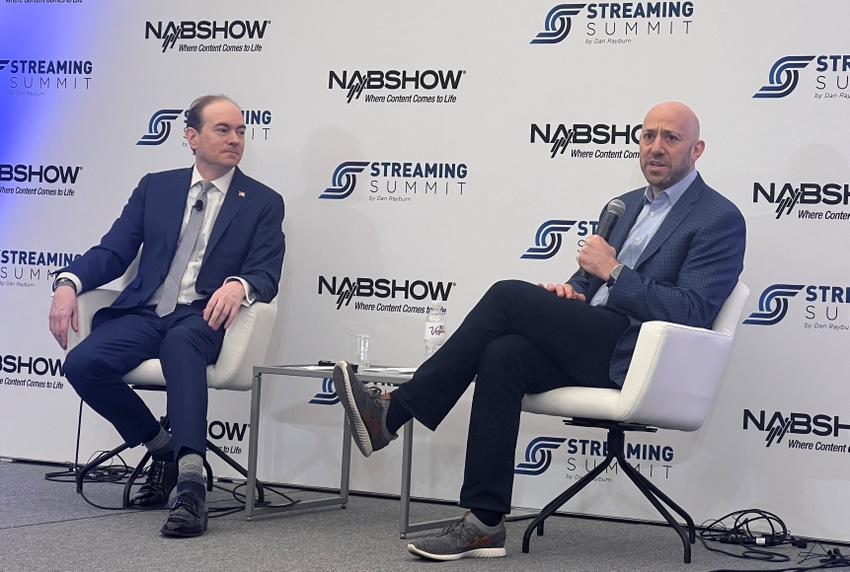Mixing ad and subscription dollars critical to the streaming model, NBCU's Strauss says
Several top premium streaming services started with a subscription model but later brought ads into the mix. Advertising is the 'anchor' to Peacock, which also uses the subscription model, says NBCU's Matt Strauss.

Building a strong subscription base initially was the big focus for premium streaming services such as Netflix, Disney+ and Max, but it's become increasingly clear that complementing the subscription model with ad-supported options also needs to be built into the overall strategy.
While Netflix, Disney+ and Max all have introduced ad-supported options, having a dual revenue stream that combines subscriptions with advertising has been a focus out of the chute for other premium offerings such as NBCU's Peacock, Paramount+ (which got its start as CBS All Access) and Hulu.
NBCU's plan from the start was to use ads to "anchor" the Peacock service as spots continued to migrate from traditional TV to the streaming world, said Matt Strauss, chairman of direct-to-consumer and international at NBCUniversal, speaking this week at NAB 2024's Streaming Summit in Las Vegas.
Launched nationally in July 2020, Peacock started off with a free, ad-supported offering with a limited library alongside two premium tiers – one with ads and another that is ad-free. Peacock dropped the free option for new subs in 2023 and now offers the ad-free tier for $11.99 per month while the ad-supported option costs $5.99 per month. Peacock ended 2024 with 30 million paid subscribers but has not broken that number down by service tier.
The bigger opportunity ahead, Strauss said, is for Peacock to support dual revenue streams as the service continues to deliver a wide range of content, including bingeable series and movies alongside live events including sporting events. That strategy is also taking shape as more ad dollars continue to flow into the streaming world and away from traditional TV.
"We built a platform designed to scale for live sports," said Strauss, who previously ran Comcast's residential services unit before helping to lead the development and launch of Peacock.
FAST becoming 'the new linear'
Strauss also remarked on the growth of free, ad-supported streaming television (FAST), a model that Peacock is supporting with linear-style feeds within the streaming service. Disney is reportedly looking to add FAST channels to the Disney+ streaming service to help build usage and engagement. Xumo, now the national streaming joint venture of Comcast and Charter Communications, is one of FAST's pioneers.
The decline of pay-TV subscriptions has reached a record pace, but the adoption of FAST shows that consumers still like an aggregated, lean-back TV experience. Meanwhile, live sporting events, including Peacock's exclusive stream earlier this year of an NFL wildcard game (exclusive, save for markets in Miami and Kansas City, which did provide local TV coverage), show that there's still some gas left in TV's tank.
The death of live TV "is grossly overstated," said Strauss, who also runs NBCU's Fandango/Vudu At Home, Rotten Tomatoes and GolfPass, and is tied in to international initiatives and partnerships such as SkyShowtime. Linear TV is still important to how people consume and enjoy video, he said.
"TV has a pulse; TV is timely," Strauss said. But FAST is becoming "the new linear," he added.
Strauss also expects bundling to complement the direct-to-consumer model. More subscribers will come to Peacock "from some form of bundling," he said.
Striking the right content balance
NBCU will continue to take a multi-faceted approach to how its programs are distributed on Peacock as well as third-party services, according to Strauss. While Peacock is getting exclusive access to originals such as Poker Face and Ted and the initial pay window for Universal films such as Oppenheimer, there are still opportunities to license other fare.
Suits, for example, continues to be a popular series on Netflix. However, the final season of the show is on Peacock. On the flip side, Peacock is making hay with past seasons of Yellowstone even as new seasons initially debut on the Paramount Network.
While streaming services need some level of exclusivity to make them valuable, there's still strategic value in monetizing the broader library through licensing and extracting the "right value" out of that content, Strauss explained.
About the Author(s)
You May Also Like



.jpg?width=300&auto=webp&quality=80&disable=upscale)








